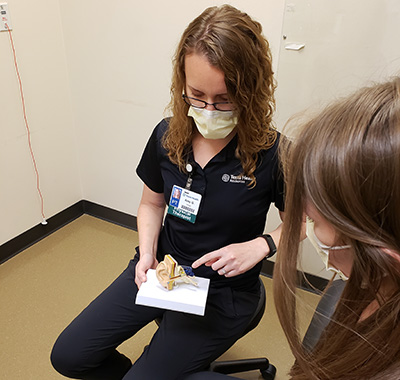Imagine tilting your head back in the shower or rolling over in bed only to become dizzy and sick to your stomach. This is something Rhonda Pittman has experienced more than once in the last year. Her mother has dealt with the same issue her whole life, and Rhonda’s father has even had similar problems.
The cause has to do with the inner ear. “Inside your ears are tiny structures called otolith organs that monitor your head's movements as well as its position related to gravity,” explains physical therapist Amy Gonzalez, DPT, of the Balance & Vestibular Rehabilitation program at Texas Health Neighborhood Care & Wellness Burleson. “These organs contain crystals that make you sensitive to gravity. Sometimes the crystals can become dislodged, most likely due to allergies, sinus pressure, trauma or a fall. Even high blood pressure can trigger an episode. When they dislodge, they can move into one of the ear’s semicircular canals — especially while you're lying down. This causes the canal to become sensitive to head position changes and lead to dizziness and other symptoms.”

Amy explaining the structures of the inner ear.
The good news in Rhonda’s case is she has found hope and better health through vestibular therapy at Texas Health Burleson. Rhonda was introduced to the hospital’s innovative program in June 2020 after she woke to a spinning room.
“I woke up dizzy and the house was spinning like the tornado in Wizard of Oz, only faster,” she says. “I made it to the sink and got sick. I then called my neighbor and she drove me to Texas Health. I was thankfully referred to Amy Gonzalez.”
Rhonda was diagnosed with Benign Paroxysmal Positional Vertigo (BPPV), a common cause of vertigo. Although BPPV may reoccur, it can be managed and its triggers avoided with ongoing therapy using specific maneuvers.
In the rehab center at Texas Health Burleson, Gonzalez worked with Rhonda during three visits to help relieve her initial symptoms. “She had very strong nausea along with the vertigo, so we proceeded with caution and only did a little work in each visit,” Gonzalez explains. “When I spoke with her via phone late in June, she was back to 100 percent.
Rhonda had two additional bouts of the BPPV later in the year. Both times, Gonzalez was able to resolve the symptoms using the Epley Maneuver. During the maneuver, Rhonda’s head was moved into different positions to coax the crystal debris to slip into an area of the inner ear where it would no longer cause her to feel dizzy and nauseated.
She admits that the maneuvers aren’t exactly pleasant, but that they serve their purpose by providing relief within days. “It’s like going through the vertigo again and again,” Rhonda says. “Amy sits me on a table and holds my head while quickly moving me backwards. The whole time I’m spinning. She has to do this to look into my eyes to see where the crystals are in my inner ear. Then she gently turns me so I’m looking at the floor until the vertigo stops. She always works at a pace that is best for me.”
Paving the Way for Better Health
Now that Rhonda knows what to look for if her BPPV returns, Gonzalez has taught her how to perform the treatment maneuver at home. “It’s not easy and it’s not fun, but I know I have to do it to get the crystals back into place and keep from having tons of symptoms,” Rhonda acknowledges.
“This is not something I give to every patient because, if performed incorrectly, the treatment will only make them dizzy without resolving the issue and in some cases can make things worse,” Gonzalez adds. “I get a little nervous when I hear patients tell me they ‘Googled’ what to do and tried it themselves. Those are often patients I end up seeing with more complications because they attempted to fix it themselves. The treatment is designed to be performed with guidance from a physical therapist or physician.”
Although the physical therapy evaluation of vestibular disorders can be done with little or no equipment, a recent addition to Texas Health Burleson’s program is aiding Gonzalez and her colleagues in their work.
“It helps significantly when infrared video goggles are available,” she notes. “I have been using them in my vestibular evaluations since March 2021. The infrared camera in the goggles allows us to view the patient’s eyes while the patient sees nothing. This is important because the way in which their eyes move directs our diagnosis and treatment. The therapist can easily view the eye movement and record it to show the patient. We can then educate them on exactly what is the cause of their symptoms and how we will treat it. Our goal is to minimize medication use, reduce headaches and nausea, prevent surgery and decrease the risk of a patient falling due to related balance issues — for improved quality of life.”
Rhonda has learned to avoid movements that might bring on her BPPV, like looking up or bending her head down too far, quick head turns and sleeping flat. She says she owes her new-found knowledge to her physical therapist, or “Super Hero”, who has taught her how to live more comfortably.
To learn more about balance and vestibular rehabilitation through Texas Health, visit Rehabilitation Services.

